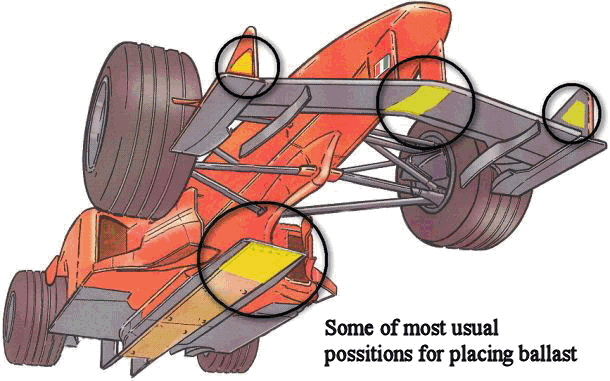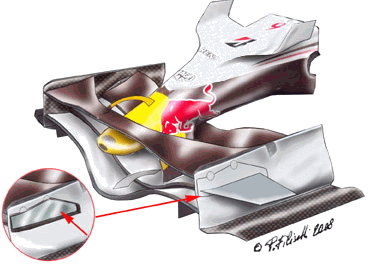Ballast

Ballast is a F1 specific tuning option. Ballast allows you to add weight to an already light car, with the specific intention of altering the weight distribution of the car. This works hand in hand with Weight Balance. Modern F1 car have ballast of more then 150 Kg. Applying very expensive and very heavy metal ballast in precise places, usually but not always on the underside of the monocoque, on the as lowest place as possible to further lower the center of gravity.
For example, on the last race of 2008, after David Coultard crush, it became clear that RedBull Racing team is using small wolfram/tungsten plates strategically placed on endplates of front wing. As on most cars, the RB4 has tiny blocks of wolfram/tungsten inside the wing's main profile, hidden from view within covered housings. But in addition to this 'standard' ballast placing, the RB4's endplates also have detachable aerodynamically shaped covers which hide extra ballast pieces (picture down). The ballast may look small, but the high density of the ballast metal means they can carry 5 to 7 kilograms. This allows the weight distribution of the car to be moved more forwards, improving its overall weight distribution.

In a complete season, a team may use ten sets of these plates, at a cost over the year of something like a half million dollars and more. Most often teams use tungsten, but some resources talk about Osmium, Iridium, Platinum, and Rhenium, very expensive, rare, but very dens materials.
Just to highlight how dense Tungsten is:
Density Tungsten: 19.35g/cm3
Density Lead: 11.35g/cm3
Say the chassis of an F1 car without ballast - with driver weighs 450kg.
So we need to make up 200kg up in ballast.
With Tungsten, that takes 10336 cm3 to do.
That's the equivalent of a 1m x 1m x 1.03cm block
Using Lead (which traditional ballast is made out of, which is why I chose lead), that 1m x 1m block would have to be 1.76cm thick, to make up the 17621cm3.
Put in another way, you need 170%, or 70% more lead by volume to make up the same mass.
So, to make sense of what I just said: F1 teams like tungsten because it is dense, and they don't have to pack as much of it into a chassis to reach the required weight. but is not expensive like Osmium, Iridium, Platinum, and Rhenium. But some teams don't care about expenses.
Ballast must be fixed, and by FIA rules can't be movable in any time of the race.
After 2014 big rule change, the biggest in recent history, and after introducing new V6 engines with complex hybrid ERS system, FIA raised a weight limit of the F1 cars from 642kg in 2013 to 690kg. As teams begin to finalise their car designs for 2014, it is emerging that a number of outfits are struggling to get near the minimum 690kg that the car and driver must weigh because heavier, more powerful energy recovery systems are heavier than anticipated. the extra 48kg will almost certainly be taken up by the new power units, meaning even less leeway for additional ballasting of the car. This represent a problem also for heavier drivers. Lighter drivers will have the luxury of being able to move a little bit of ballast around the car in order to bring it up to the minimum weight. Heavier drivers will not have this luxury and that can create a problems for them. That means lighter drivers, such as Felipe Massa, who weighs 59 kilos, will have an advantage over taller drivers like Nico Hulkenberg, who weighs in at 74 kilos. The preference is for the car and driver to weigh in below the minimum weight and for ballast to make up the difference. The heavier a driver is the less ballast the teams have to play with. That means that taller drivers like Hulkenberg face the risk of being overlooked for competitive seats simply because they are too heavy.
1kg of weight equates to about 0.035secs a lap on an average circuit. So, for example, Sebastain Vettel (65kg) will be 0.35s faster on a lap than Nico Hulkenberg (75kg) all other things being equal.
A taller driver is also at a disadvantage because his weight is high up in the car.
The sport has moved on a long way since Carel Godin de Beaufort raced in the late 1950s and 1960s in his own car. He was of such a size - he at one time topped 100kg - he was nicknamed "Fatty Porsche".







